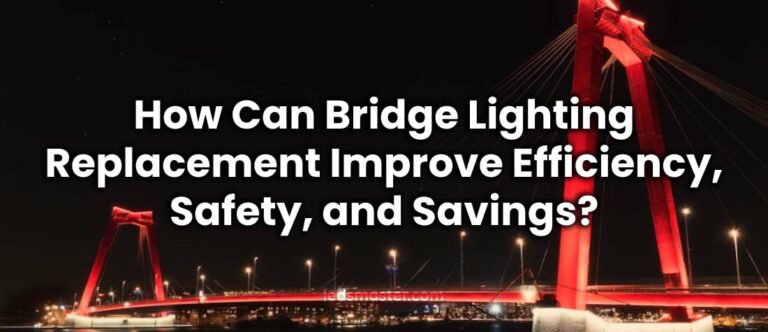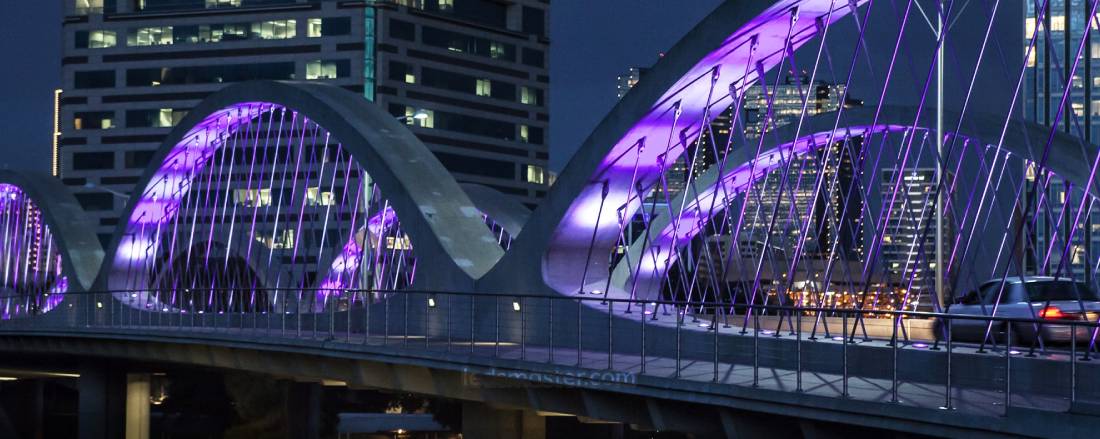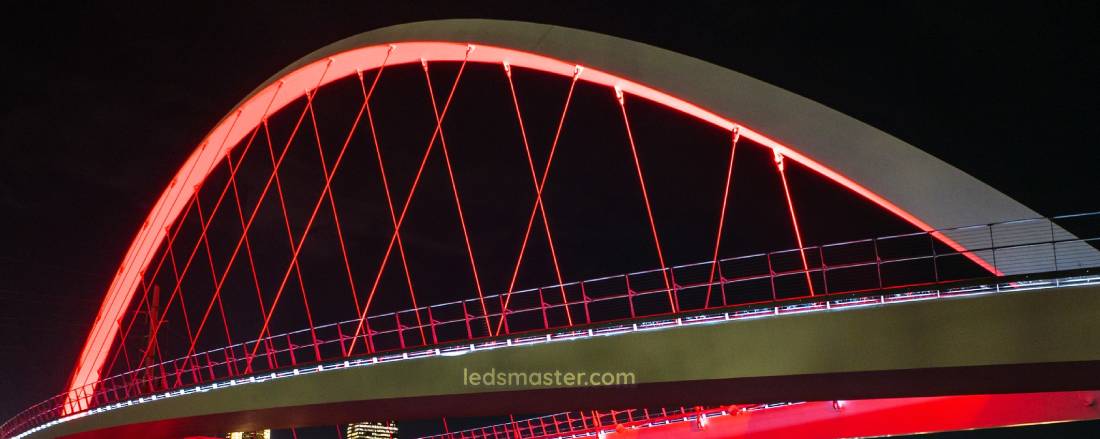
Bridge lighting not only ensures safety for drivers and pedestrians but also transforms the visual appeal of a city’s infrastructure. Replacing outdated lighting systems with modern, energy-efficient solutions can enhance both functionality and aesthetics, creating a safer and more captivating experience for everyone who crosses or views the bridge.
Get your complimentary lighting design today
Over time, advances in lighting technology have introduced options that not only illuminate but also reduce environmental impact and adapt to various weather conditions. Proper lighting can make bridges safer for pedestrians, cyclists, and motorists while offering dynamic displays that enhance the landscape.
Table of Contents
ToggleModern lighting solutions for bridges typically focus on energy efficiency, durability, and adaptability to different conditions.

LED lighting is one of the widely adopted solutions for bridge lighting replacements. LEDs have a longer lifespan and consume significantly less energy compared to traditional incandescent or halogen bulbs. They can endure extreme weather conditions, making them ideal for bridges that span over bodies of water or are exposed to constant weather changes. LED lights also provide better brightness control and can be installed in different configurations, allowing bridge designers to achieve uniform lighting across the structure.
One of the advantages of LED lighting is its low maintenance cost. Once installed, the need for frequent replacements diminishes due to the durability of LED technology. Additionally, LEDs generate less heat, contributing to longer life spans and reducing energy loss. These factors make LED lighting a great choice for urban bridges, tunnels, and overpasses, where energy savings and longevity are prioritized.
Solar-powered lighting is another option, particularly for bridges located in remote or hard-to-access areas where providing electrical infrastructure can be challenging. Solar panels harness energy during the day and power the lights at night, eliminating the need for a continuous connection to the electrical grid. Solar-powered lighting systems can often integrate with LED lights, combining the advantages of both technologies.
Solar bridge lighting also reduces environmental impact, as it generates electricity without emitting greenhouse gases. With the proper setup, solar-powered lights can continue to operate during extended cloudy periods, ensuring that bridges remain illuminated without relying on traditional energy sources.
Color-changing lighting adds a dynamic element to bridges, creating visually striking displays that can be customized for special occasions, holidays, or events. These lights are often integrated into LED systems and can be programmed to shift between different hues, offering a range of options for customization. This feature not only enhances the aesthetic appeal of bridges but also provides an opportunity to create a unique identity for the structure.
Color-changing lights are often used on iconic bridges, giving city planners the flexibility to adapt lighting schemes for public celebrations, awareness campaigns, or cultural events. The ability to shift between soft whites to vibrant colors allows bridges to serve as public art installations while maintaining functionality. Programmable lighting control systems can further enhance the experience, enabling specific light patterns and sequences.
There are several factors that contribute to the decision to replace existing lighting systems on bridges. Aging infrastructure, outdated lighting technology, and the desire to improve energy efficiency often drive the need for updated solutions.
As bridges age, so do their lighting systems. The wear and tear caused by weather, vehicle vibrations, and other environmental factors can degrade the performance of the lights. Traditional lighting technologies, such as sodium or halogen lamps, have limited lifespans and often require frequent maintenance. As the costs of maintaining older systems accumulate, replacing them with modern alternatives becomes a more feasible option.
Upgrading to newer lighting technologies allows for better performance and reliability, especially in conditions where lighting is critical for safety, such as foggy or rainy weather. Older systems may not meet modern lighting standards, leaving parts of the bridge dimly lit or completely unilluminated. Replacement lighting systems address these issues and provide better coverage and uniformity across the entire structure.
Traditional lighting systems often consume large amounts of energy, making them costly to operate, especially for larger bridges that require numerous light fixtures. High electricity bills, combined with the environmental concerns associated with excessive energy use, are strong motivators for replacing older lighting with energy-efficient alternatives.
LED and solar-powered lighting systems offer significant energy savings, reducing the environmental footprint of the bridge. Lower energy consumption also results in cost savings for municipalities and bridge operators, freeing up resources for other infrastructure improvements. By investing in energy-efficient lighting, cities and towns can reduce their overall energy demand while maintaining or even enhancing the quality of light provided.
The impact of outdated lighting on the environment goes beyond just energy consumption. Traditional lighting systems, such as high-pressure sodium lights, often contribute to light pollution, which can affect local ecosystems, especially in areas near water or nature reserves. Modern bridge lighting solutions are designed to minimize light pollution by focusing the light precisely where it is needed, reducing unnecessary illumination of the surrounding environment.
LED lighting can be designed to cast focused beams, preventing light from spilling into areas where it may disrupt wildlife or contribute to glare. Solar-powered lighting systems also reduce the reliance on nonrenewable energy sources, promoting sustainability in urban planning. By adopting modern lighting replacements, bridges can maintain functionality while supporting eco-friendly practices.
Safety standards for bridge lighting have evolved over the years, especially as new research highlights the relationship between proper lighting and accident prevention. Older lighting systems may no longer meet the brightness or uniformity levels required to ensure the safety of motorists, cyclists, and pedestrians. Replacing lighting systems ensures compliance with modern safety standards, reducing the likelihood of accidents caused by poor visibility.
Adequate lighting helps drivers navigate sharp curves, narrow lanes, or complex interchanges commonly found on bridges. For pedestrians and cyclists, proper lighting is crucial for visibility and preventing collisions with vehicles or other individuals. New lighting systems can also be integrated with smart technologies that adjust brightness based on traffic patterns or weather conditions, further enhancing safety.
Color-changing bridge lighting is an increasingly popular feature in modern lighting designs. As part of a comprehensive replacement project, installing lights capable of shifting colors adds a unique visual element to the structure. These lights allow for creative freedom and enable bridges to become more than just utilitarian structures.

Bridges that incorporate color-changing lights often become landmarks in their own right, drawing tourists and residents alike to view the stunning light displays. The ability to switch between colors allows cities to create unique spectacles, especially for holidays, festivals, and national celebrations. For example, bridges can be illuminated in patriotic colors for national holidays or themed colors for sports events.
The aesthetic appeal of color-changing lights contributes to the cultural and social value of a city, turning bridges into symbols of civic pride. The ability to program these lights to display particular sequences or animations makes it possible to constantly refresh the visual appeal of a bridge, keeping it relevant and engaging for years to come.
Color-changing lights are often controlled through centralized systems that allow for automated or manual adjustments. This creates opportunities for dynamic lighting experiences, where different colors, brightness levels, or patterns can be applied in real-time. Whether it’s a subtle fade between colors or a more dramatic pulsating effect, these lighting systems allow bridges to interact with their surroundings in innovative ways.
Incorporating motion sensors or time-based triggers can enhance the effect further. For instance, lights can shift from one color to another as vehicles pass, or they can change gradually as dusk settles into night. This dynamic interplay of light enhances the experience of traveling across or viewing the bridge from afar.
Many cities use color-changing bridge lights to raise awareness for public causes or events. For example, bridges may be lit in pink for breast cancer awareness or in green for environmental initiatives. This use of lighting transforms bridges into public canvases for engagement, allowing the city to convey messages or support causes visually.
Because these lighting systems are so flexible, they can be adapted to a wide range of needs. Planners can use the same bridge to celebrate local cultural festivals or to raise awareness for international movements. This versatility makes color-changing lights a valuable tool for urban planners looking to foster a sense of community.
Replacing the lighting system on a bridge requires careful consideration of several factors, from the design and durability of the lights to the safety and environmental impact of the new system.
This ensures that all areas are well-lit, minimizing dark spots or excessive glare. The design of the lighting system must account for the bridge’s structural layout, such as curves, elevation changes, and the presence of pedestrian paths.
A well-designed lighting system not only improves visibility but also enhances the bridge’s architectural features. Modern lighting technologies allow for better control over the direction and intensity of light, ensuring that the bridge is illuminated without excessive energy waste. This level of control also prevents light from spilling into unintended areas, reducing light pollution.
Choosing energy-efficient lighting systems can reduce operating costs over time. While the initial investment in LED or solar-powered lighting systems may be higher, the long-term benefits of reduced energy consumption and maintenance make them cost-effective. Additionally, modern lighting solutions often come with smart controls, allowing for dimming or adjustments based on real-time conditions, further improving energy savings.
Bridges are exposed to a wide range of environmental conditions, including high winds, rain, and extreme temperatures. The lighting system installed must withstand these conditions without compromising performance. For instance, fixtures should be water-resistant and designed to endure prolonged exposure to moisture, particularly for bridges near bodies of water.
The lighting system must provide adequate visibility for all users of the bridge, including motorists, cyclists, and pedestrians. Poorly lit bridges can pose significant hazards, particularly in areas with sharp turns or heavy traffic. Replacing outdated lighting systems ensures that safety standards are met and that all areas of the bridge are adequately illuminated.
Replacing bridge lighting goes beyond simply upgrading fixtures; it involves improving energy efficiency, enhancing safety, and incorporating modern design elements like color-changing systems. Whether through the adoption of LED, solar-powered lights, or dynamic color schemes, bridge lighting replacement projects can transform the functionality and appearance of bridges for years to come.